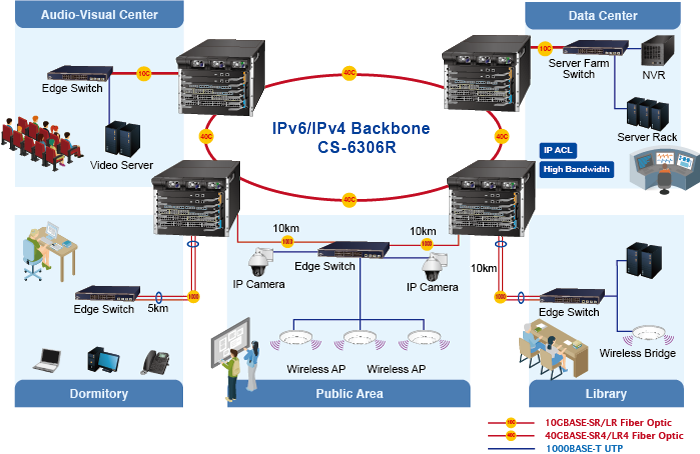Feature
Hardware and Performance
- 6 open module slots design:
- Up to 2 Management Modules
- Up to 4 Switch Modules
- Hot-swappable switching modules
- 1 RJ45 serial console interface on Management Module for switch basic management and setup
- 6 open module slots design:
Redundant Power System
- 3 power slots
- 100~240V AC and 36-72V DC power redundancy
- 1 default AC power supply
- 2 additional open slots for optional power supply
- Active-active redundant power failure protection
- Backup of catastrophic power failure on one supply
IP Routing Features
- IPv4 Routing protocol supports RIP v1/v2, OSPFv2 and BGP4
- IPv6 Routing protocol supports RIPng, OSPFv3 and BGP4+
- Routing interface provides VLAN routing mode
- Policy-based Routing (PBR) for IPv4
- VRRP protocol for redundant routing deployment
- Supports route redistribution
Multicast Routing Features
- Supports Multicast Routing Protocols:
- PIM-DM (Protocol Independent Multicast – Dense Mode)
- PIM-SM (Protocol Independent Multicast – Sparse Mode)
- PIM-SSM (Protocol Independent Multicast – Source-Specific Multicast Mode)
- Supports IGMP v1/v2/v3
- Supports Multicast Routing Protocols:
Layer 2 Features
- Supports VLAN
- IEEE 802.1Q tag-based VLAN
- Provider Bridging (VLAN Q-in-Q, IEEE 802.1ad) supported
- GVRP for dynamic VLAN management
- Private VLAN
- Supports Link Aggregation
- 802.3ad Link Aggregation Control Protocol (LACP)
- Cisco ether-channel (static trunk)
- Supports Spanning Tree Protocol
- STP, IEEE 802.1D (Classic Spanning Tree Protocol)
- RSTP, IEEE 802.1w (Rapid Spanning Tree Protocol)
- MSTP, IEEE 802.1s (Multiple Spanning Tree Protocol, spanning tree by VLAN)
- Port mirroring to monitor the incoming or outgoing traffic on a particular port (many to 1)
- Loop protection to avoid broadcast loops
- Link Layer Discovery Protocol (LLDP)
- Ethernet OAM 802.3ah/802.1ag/ITU-Y.1731
- Supports VLAN
Quality of Service
- Ingress shaper and egress rate limit per port bandwidth control
- 8 priority queues on all switch ports
- IEEE 802.1p CoS/DSCP/Precedence
- VLAN ID
- Policy-based ingress and egress QoS
Multicast
- Supports IPv4 IGMP snooping v1, v2 and v3
- Supports IPv6 MLD snooping v1 and v2
- Querier mode support
- MVR (Multicast VLAN Registration)
Security
- Authentication
- IEEE 802.1x port-based network access authentication
- Built-in RADIUS client to cooperate with the RADIUS servers
- RADIUS/TACACS+ users access authentication
- Access Control List
- IP-based Access Control List (ACL)
- MAC-based Access Control List (ACL)
- Time-based ACL
- DHCP Snooping to filter distrusted DHCP messages
- Dynamic ARP Inspection discards ARP packets with invalid MAC address to IP address binding
- IP Source Guard prevents IP spoofing attacks
- Authentication
Management
- IPv4 and IPv6 dual stack management
- Switch Management Interfaces
- Console and Telnet Command Line Interface
- HTTP web switch management
- SNMP v1 and v2c switch management
- SSHv2, SSLv3, TLSv1.0 and SNMP v3 secure access
- SNMP Management
- Four RMON groups (history, statistics, alarms, and events)
- SNMP trap for interface Link Up and Link Down notification
- Built-in Trivial File Transfer Protocol (TFTP) client
- BOOTP and DHCP for IP address assignment
- System Maintenance
- Firmware upload/download via HTTP
- Reset button for system reboot or reset to factory default
- Dual images
- DHCP Functions:
- DHCP Relay
- DHCP Option 82
- DHCP Server
- User Privilege levels control
- Network Time Protocol (NTP) and SNTP
- Network Diagnostic
- SFP-DDM (Digital Diagnostic Monitor)
- ICMP remote IP ping
- Syslog remote alarm
- System Log
Stacking Management
- Virtualized multiple CS-6306R switches integrated into one logical device
- Single IP address stack management, supporting up to 2 hardware units stacked together
- Stacking architecture supports redundancy Ring mode





